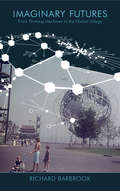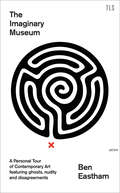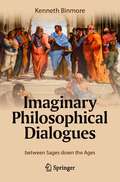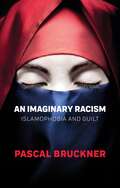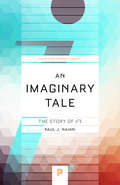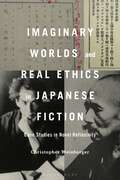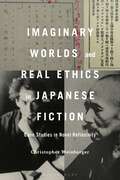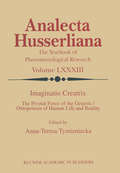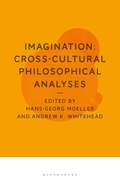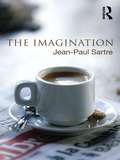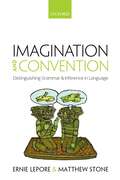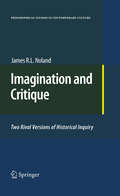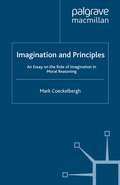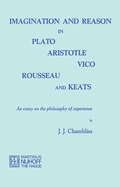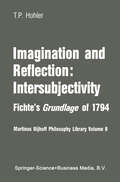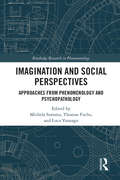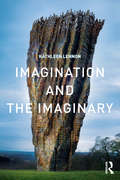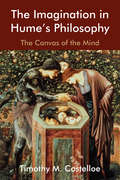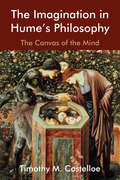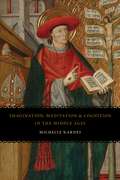- Table View
- List View
Imaginary Futures: From Thinking Machines to the Global Village
by Richard BarbrookThis book is a history of the future. It shows how our contemporary understanding of the Internet is shaped by visions of the future that were put together in the 1950s and 1960s.*BR**BR*At the height of the Cold War, the Americans invented the only working model of communism in human history: the Internet. Yet, for all of its libertarian potential, the goal of this hi-tech project was geopolitical dominance: the ownership of time was control over the destiny of humanity. The potentially subversive theory of cybernetics was transformed into the military-friendly project of 'artificial intelligence'. Capitalist growth became the fastest route to the 'information society'. The rest of the world was expected to follow America's path into the networked future. *BR**BR*Today, we're still being told that the Internet is creating the information society - and that America today is everywhere else tomorrow. Thankfully, at the beginning of the twenty-first century, the DIY ethic of the Internet shows that people can resist these authoritarian prophecies by shaping information technologies in their own interest. Ultimately, if we don't want the future to be what it used to be, we must invent our own, improved and truly revolutionary future.
Imaginary Futures: From Thinking Machines to the Global Village
by Richard BarbrookThis book is a history of the future. It shows how our contemporary understanding of the Internet is shaped by visions of the future that were put together in the 1950s and 1960s.*BR**BR*At the height of the Cold War, the Americans invented the only working model of communism in human history: the Internet. Yet, for all of its libertarian potential, the goal of this hi-tech project was geopolitical dominance: the ownership of time was control over the destiny of humanity. The potentially subversive theory of cybernetics was transformed into the military-friendly project of 'artificial intelligence'. Capitalist growth became the fastest route to the 'information society'. The rest of the world was expected to follow America's path into the networked future. *BR**BR*Today, we're still being told that the Internet is creating the information society - and that America today is everywhere else tomorrow. Thankfully, at the beginning of the twenty-first century, the DIY ethic of the Internet shows that people can resist these authoritarian prophecies by shaping information technologies in their own interest. Ultimately, if we don't want the future to be what it used to be, we must invent our own, improved and truly revolutionary future.
The Imaginary Museum: A Personal Tour Of Contemporary Art Featuring Ghosts, Nudity And Disagreements
by Ben EasthamJoin the art critic Ben Eastham on a private tour of an extraordinary museum. Let him walk you through a building constructed from memory and filled with a series of bewildering art works, while he delivers a guide comprised of personal experience, professional expertise and sympathy.
Imaginary Philosophical Dialogues: between Sages down the Ages
by Kenneth BinmoreHow would Plato have responded if his student Aristotle had ever challenged his idea that our senses perceive nothing more than the shadows cast upon a wall by a true world of perfect ideals? What would Charles Darwin have said to Karl Marx about his claim that dialectical materialism is a scientific theory of evolution? How would Jean-Paul Sartre have reacted to Simone de Beauvoir’s claim that the Marquis de Sade was a philosopher worthy of serious attention? This light-hearted book proposes answers to such questions by imagining dialogues between thirty-three pairs of philosophical sages who were alive at the same time. Sometime famous sages get a much rougher handling than usual, as when Adam Smith beards Immanuel Kant in his Konigsberg den. Sometimes neglected or maligned sages get a chance to say what they really believed, as when Epicurus explains that he wasn’t epicurean. Sometimes the dialogues are about the origins of modern concepts, as when Blaise Pascal and Pierre de Fermat discuss their invention of probability, or when John Nash and John von Neumann discuss the creation of game theory. Even in these scientific cases, the intention is that the protagonists come across as fallible human beings like the rest of us, rather than the intellectual paragons of philosophical textbooks.
An Imaginary Racism: Islamophobia and Guilt
by Pascal Bruckner‘Islamophobia’ is a term that has existed since the nineteenth century. But in recent decades, argues Pascal Bruckner in his controversial new book, it has become a weapon used to silence criticism of Islam. The term allows those who brandish it in the name of Islam to ‘freeze’ the latter, making reform difficult. Whereas Christianity and Judaism have been rejuvenated over the centuries by external criticism, Islam has been shielded from critical examination and has remained impervious to change. This tendency is exacerbated by the hypocrisy of those Western defenders of Islam who, in the name of the principles of the Enlightenment, seek to muzzle its critics while at the same time demanding the right to chastise and criticize other religions. These developments, argues Bruckner, are counter-productive for Western democracies as they struggle with the twin challenges of immigration and terrorism. The return of religion in those democracies must not be equated with the defence of fanaticism, and the right to religious freedom must go hand in hand with freedom of expression, an openness to criticism, and a rejection of all forms of extremism. There are already more than enough forms of racism; there is no need to imagine more. While all violence directed against Muslims is to be strongly condemned and punished, defining these acts as ‘Islamophobic’ rather than criminal does more to damage Islam and weaken the position of Muslims than to strengthen them.
An Imaginary Tale: The Story of √-1 (PDF)
by Paul J. NahinToday complex numbers have such widespread practical use--from electrical engineering to aeronautics--that few people would expect the story behind their derivation to be filled with adventure and enigma. In An Imaginary Tale, Paul Nahin tells the 2000-year-old history of one of mathematics' most elusive numbers, the square root of minus one, also known as i. He recreates the baffling mathematical problems that conjured it up, and the colorful characters who tried to solve them.In 1878, when two brothers stole a mathematical papyrus from the ancient Egyptian burial site in the Valley of Kings, they led scholars to the earliest known occurrence of the square root of a negative number. The papyrus offered a specific numerical example of how to calculate the volume of a truncated square pyramid, which implied the need for i. In the first century, the mathematician-engineer Heron of Alexandria encountered I in a separate project, but fudged the arithmetic; medieval mathematicians stumbled upon the concept while grappling with the meaning of negative numbers, but dismissed their square roots as nonsense. By the time of Descartes, a theoretical use for these elusive square roots--now called "imaginary numbers"--was suspected, but efforts to solve them led to intense, bitter debates. The notorious i finally won acceptance and was put to use in complex analysis and theoretical physics in Napoleonic times.Addressing readers with both a general and scholarly interest in mathematics, Nahin weaves into this narrative entertaining historical facts and mathematical discussions, including the application of complex numbers and functions to important problems, such as Kepler's laws of planetary motion and ac electrical circuits. This book can be read as an engaging history, almost a biography, of one of the most evasive and pervasive "numbers" in all of mathematics.
Imaginary Worlds and Real Ethics in Japanese Fiction: Case Studies in Novel Reflexivity
by Professor or Dr. Christopher WeinbergerCan novels contribute to the ethical lives of readers? What responsibilities might they bear in representing others? Are we ethically accountable for how we read fiction? This study takes up modern Japanese fiction and metafiction, subjects overwhelmingly ignored by Anglophone scholarship on novel ethics, to discover pioneering answers to these and other questions. Each chapter offers new readings of major works of modern Japanese literature (1880s through 1920s) that experiment with the capacity of novel narration to involve readers in ethically freighted encounters. Christopher Weinberger shows that Mori Ogai and Akutagawa Ryunosuke help to address key issues in new ethical theories today: debates about the roles that identification and empathy play in novel ethics; concerns about the representation of “otherness” and alterity in novels; divergence between cognitive and affective theories of ethics; widespread disagreement about what novel ethics obtain in the experience of reading, the effects of reading, or the form or content of novel representation; and, finally, concerns with bias and appropriation in the study of world literature. Concluding with a jump to the present, Imaginary Worlds and Real Ethics in Japanese Fiction puts on display a startling continuity between the methods of Japan's modern novel progenitors and those of novelists at the forefront of global literature today, especially Haruki Murakami. Ultimately, this book models an original approach to ethical criticism while demonstrating the relevance of modern Japanese fiction for rethinking contemporary theories of the novel.
Imaginary Worlds and Real Ethics in Japanese Fiction: Case Studies in Novel Reflexivity
by Professor or Dr. Christopher WeinbergerCan novels contribute to the ethical lives of readers? What responsibilities might they bear in representing others? Are we ethically accountable for how we read fiction? This study takes up modern Japanese fiction and metafiction, subjects overwhelmingly ignored by Anglophone scholarship on novel ethics, to discover pioneering answers to these and other questions. Each chapter offers new readings of major works of modern Japanese literature (1880s through 1920s) that experiment with the capacity of novel narration to involve readers in ethically freighted encounters. Christopher Weinberger shows that Mori Ogai and Akutagawa Ryunosuke help to address key issues in new ethical theories today: debates about the roles that identification and empathy play in novel ethics; concerns about the representation of “otherness” and alterity in novels; divergence between cognitive and affective theories of ethics; widespread disagreement about what novel ethics obtain in the experience of reading, the effects of reading, or the form or content of novel representation; and, finally, concerns with bias and appropriation in the study of world literature. Concluding with a jump to the present, Imaginary Worlds and Real Ethics in Japanese Fiction puts on display a startling continuity between the methods of Japan's modern novel progenitors and those of novelists at the forefront of global literature today, especially Haruki Murakami. Ultimately, this book models an original approach to ethical criticism while demonstrating the relevance of modern Japanese fiction for rethinking contemporary theories of the novel.
Imaginatio Creatrix: The Pivotal Force of the Genesis/Ontopoiesis of Human Life and Reality (Analecta Husserliana #83)
by Anna-Teresa TymienieckaThe fulgurating power of creative imagination - Imaginatio Creatrix - setting in motion the Human Condition within the-unity-of-everything there-is-alive is the key to the rebirth of philosophy. From as early as 1971 (see the third volume of the Analecta Husserliana series, The Phenomenological Realism of the Possible Worlds, Anna-Teresa Tymieniecka, ed.), Imaginatio Creatrix has been the leitmotif for the research work of the World Phenomenology Institute (now published in eighty-three Analecta Husserliana volumes), one that is eliciting echoes from all around. Husserl's diagnosis of a crisis in Western science and culture, the inspiration of much of postmodern phenomenology, has yielded place to a wave of scientific discovery, technological invention, and change in societal life, individual lifestyles, the arts, etc. These throw a glaring light on human creative genius and the crucial role of the imagination that gives it expression. This present collection is an instance of that expression and the response it evokes. It manifests the role of imagination in forming and interpreting our world -in-transformation in a new way and opens our eyes to marvel at the new world on the way. Papers by: Semiha Akinci, John Baldacchino, Angela Ales Bello, Elif Cirakman, Tracy Colony, Carmen Cozma, Charles de Brantes, Mamuka G. Dolidze, Edward Domagala, Shannon Driscoll, Nader E1-Bizri, Ignacy Fiut, William Franke, Elga Freiberga, Beata Furgalska, Nicoletta Ghigi, Jennifer Anna Gosetti-Ferencei, David Grünberg, Oliver W. Holmes, Milan Jaros, Rolf Kühn, Maija Kule, Rimma Kurenkova, Matthew Landrus, Nancy Mardas, David Martinez, William D. Melaney, Mieczyslaw, Pawel Migon, Martin Nkafu Nkemnkia, Leszek Pyra, W. Kim Rogers, Bruce Ross, Osvaldo Rossi, Julio E. Rubio, Diane G. Scillia, Mina Sehdev, Dennis E. Skocz, Mariola Sulkowska, Robert D. Sweeney, Jan Szmyd, Piero Trupia, Anna-Teresa Tymieniecka, Richard T. Webster.
Imagination: Cross-Cultural Philosophical Analyses
by Hans-Georg Moeller Andrew WhiteheadImagination: Cross-Cultural Philosophical Analyses is a rare intercultural inquiry into the conceptions and functions of the imagination in contemporary philosophy. Divided into East Asian, comparative, and post-comparative approaches, it brings together a leading team of philosophers to explore the concepts of the illusory and illusions, the development of fantastic narratives and metaphors, and the use of images and allegories across a broad range of traditions. Chapters discuss how imagination has been interpreted by thinkers such as Zhuangzi, Plato, Confucius, Heidegger, and Nietzsche. By drawing on sources including Buddhist aesthetics, Daoism, and analytic philosophy of mind, this cross-cultural collection shows how the imagination can be an indispensable tool for the comparative philosopher, opening up new possibilities for intercultural dialogue and critical engagement.
Imagination: Cross-Cultural Philosophical Analyses
by Professor Hans-Georg Moeller Andrew WhiteheadImagination: Cross-Cultural Philosophical Analyses is a rare intercultural inquiry into the conceptions and functions of the imagination in contemporary philosophy. Divided into East Asian, comparative, and post-comparative approaches, it brings together a leading team of philosophers to explore the concepts of the illusory and illusions, the development of fantastic narratives and metaphors, and the use of images and allegories across a broad range of traditions. Chapters discuss how imagination has been interpreted by thinkers such as Zhuangzi, Plato, Confucius, Heidegger, and Nietzsche. By drawing on sources including Buddhist aesthetics, Daoism, and analytic philosophy of mind, this cross-cultural collection shows how the imagination can be an indispensable tool for the comparative philosopher, opening up new possibilities for intercultural dialogue and critical engagement.
The Imagination
by Jean-Paul Sartre‘No matter how long I may look at an image, I shall never find anything in it but what I put there. It is in this fact that we find the distinction between an image and a perception.' - Jean-Paul Sartre L’Imagination was published in 1936 when Jean-Paul Sartre was thirty years old. Long out of print, this is the first English translation in many years. The Imagination is Sartre’s first full philosophical work, presenting some of the basic arguments concerning phenomenology, consciousness and intentionality that were to later appear in his master works and be so influential in the course of twentieth-century philosophy. Sartre begins by criticising philosophical theories of the imagination, particularly those of Descartes, Leibniz and Hume, before establishing his central thesis. Imagination does not involve the perception of ‘mental images’ in any literal sense, Sartre argues, yet reveals some of the fundamental capacities of consciousness. He then reviews psychological theories of the imagination, including a fascinating discussion of the work of Henri Bergson. Sartre argues that the ‘classical conception’ is fundamentally flawed because it begins by conceiving of the imagination as being like perception and then seeks, in vain, to re-establish the difference between the two. Sartre concludes with an important chapter on Husserl’s theory of the imagination which, despite sharing the flaws of earlier approaches, signals a new phenomenological way forward in understanding the imagination. The Imagination is essential reading for anyone interested in the philosophy of Jean-Paul Sartre, phenomenology, and the history of twentieth-century philosophy. This new translation includes a helpful historical and philosophical introduction by Kenneth Williford and David Rudrauf. Also included is Maurice Merleau-Ponty’s important review of L’Imagination upon its publication in French in 1936. Translated by Kenneth Williford and David Rudrauf.
The Imagination
by Jean-Paul Sartre‘No matter how long I may look at an image, I shall never find anything in it but what I put there. It is in this fact that we find the distinction between an image and a perception.' - Jean-Paul Sartre L’Imagination was published in 1936 when Jean-Paul Sartre was thirty years old. Long out of print, this is the first English translation in many years. The Imagination is Sartre’s first full philosophical work, presenting some of the basic arguments concerning phenomenology, consciousness and intentionality that were to later appear in his master works and be so influential in the course of twentieth-century philosophy. Sartre begins by criticising philosophical theories of the imagination, particularly those of Descartes, Leibniz and Hume, before establishing his central thesis. Imagination does not involve the perception of ‘mental images’ in any literal sense, Sartre argues, yet reveals some of the fundamental capacities of consciousness. He then reviews psychological theories of the imagination, including a fascinating discussion of the work of Henri Bergson. Sartre argues that the ‘classical conception’ is fundamentally flawed because it begins by conceiving of the imagination as being like perception and then seeks, in vain, to re-establish the difference between the two. Sartre concludes with an important chapter on Husserl’s theory of the imagination which, despite sharing the flaws of earlier approaches, signals a new phenomenological way forward in understanding the imagination. The Imagination is essential reading for anyone interested in the philosophy of Jean-Paul Sartre, phenomenology, and the history of twentieth-century philosophy. This new translation includes a helpful historical and philosophical introduction by Kenneth Williford and David Rudrauf. Also included is Maurice Merleau-Ponty’s important review of L’Imagination upon its publication in French in 1936. Translated by Kenneth Williford and David Rudrauf.
Imagination and Convention: Distinguishing Grammar and Inference in Language
by Ernie Lepore Matthew StoneHow do hearers manage to understand speakers? And how do speakers manage to shape hearers' understanding? Lepore and Stone show that standard views about the workings of semantics and pragmatics are unsatisfactory. They offer a new account of language as a specifically social competence for making our ideas public. They argue that this approach is a good way to target the distinctive mechanisms and problems at play in explaining the human faculty of language. At the same time, this view embraces the diverse dimensions of meaning that linguists have discovered. This is the right way to delimit semantics.
Imagination and Critique: Two Rival Versions of Historical Inquiry (Philosophical Studies in Contemporary Culture #19)
by James R. NolandThis book is most easily described as philosophy of history; however, this descr- tion may be a little misleading. Truly, this is a work of applied philosophy that was originally conceived not in a philosophy seminar but in a school of public policy. As a philosopher learning about the study of public policy formation, I was f- quently struck by what I perceived to be two very different sets of assumptions and methods at work. I found these assumptions and methods to be mutually exclusive conceptually, but they were often employed simultaneously. On the one hand, it was often accepted as given when studying past policy changes and political events that history is shaped by impersonal forces, that p- ple’s actions can, and ought only to be understood as manifestations of their own material interests, and that individuals are to be identi?ed as representatives of their respective demographic categories. Thus, for example, the events in question were explained in terms of the race or class of the various parties. When such an approach was challenged with an appeal to the actual arguments and stated rationales of the participants of the historical moment in question, this was taken to be an option that might be employed either in conjunction with the former method or as an alter- tive. Which method one chose to emphasize or employ exclusively seemed more a function of inclination or intuition than rational adjudication.
Imagination and Principles: An Essay on the Role of Imagination in Moral Reasoning
by M. CoeckelberghWhat does it mean to say that imagination plays a role in moral reasoning, and what are the theoretical and practical implications? Engaging with three traditions in moral theory and confronting them with three contexts of moral practice, this book comprehensively explores these questions and the relation between imagination and principles.
Imagination and Reason in Plato, Aristotle, Vico, Rousseau and Keats: An Essay on the Philosophy of Experience
by J.J. ChamblissThe present essay grew out of an inte:rest in exploring the relationship be tween "imagination" and "reason" in the history of naturalistic thinking. The essay tries to show something of the spirit of naturalism coming to terms with the place of imagination and reason in knowing, making, and doing as activities of human experience. This spirit is discussed by taking as its point of departure the thinking of five writers: Plato, Aristotle, Giam battista Vieo, Jean-Jacques Rousseau, and John Keats. Plato and Aristotle are considered as spokesmen of reason in a world which appeared to be dominated by non-reason. They found it essential for human beings to try to learn how to distinguish between the work of imagin ation and the work of reason. In trying to make such a distinction, it becomes clear that imagination has its legitimate place, along with reason, in human activity. Or we might say that determining the place which each has is a continuing problem when human beings take seriously what is involved in shaping mind and character.
Imagination and Reflection: Fichte’s Grundlage of 1794 (Martinus Nijhoff Philosophy Library #8)
by Thomas P. HohlerThis work resulted from my interests in several flDldam ental issues of contemporary phenomenology. Originally, their focal point was 1) the role and importance of the subject in philosophical activity and 2) the subject's finitude. To gain a perspective on these issues, a possible approach seemed to lie in the direction of the transcendental imagination and its relation to tim e. This focus on the imagination, of course, led to Fichte's egological philosophy that explicitly centers on the imagination. Here both issues are raised together. The reader of the Fichtean texts cannot for long hesitate to pose the question of intersubjectivity. These three issues-imagination, reflection, and inter subjectivity-formed the basis of the present work. Since such a work could never be completed if it were not for those num erot5 discussions and friendly conversation with friends and colleagues with whom philosophy is always alive, I wish to acknowledge my gratitude specifically to the following people: Professor Andre Schuwer, of Duquesne University, for his encouragement, critical reading of the work, and his comments that have greatly aided me in the writing of the present work; Professor John Sallis, Chairman of the Philosophy Department of Duquesne University, whose interest in Fichte provided invaluable insights and approaches to the issues; Professor Paul Ricoeur, University of Paris and University of Chicago, whose reading and encouragement greatly helped in the work's publication; Professor Samuel Ijsseling, University of Leuven, who introduced me to Martinus Nijhoff Publishers; Professor G. A.
Imagination and Social Perspectives: Approaches from Phenomenology and Psychopathology (Routledge Research in Phenomenology)
by Michela Summa Thomas Fuchs Luca VanzagoOur experience of other individuals as minded beings goes hand in hand with the awareness that they have a unique epistemic and emotional perspective on the experienced objects and situations. The same object can be seen from many different points of view, an event can awaken different emotional reactions in different individuals, and our position-takings can in part be mediated by our belonging to some social or cultural groups. All these phenomena can be described by referring to the metaphor of perspective. Assuming that there are different, and irreducible, perspectives we can take on the experienced world, and on others as experiencing the same world, the phenomenon of mutual understanding can consistently be understood in terms of perspectival flexibility. This edited volume investigates the different processes in which perspectival flexibility occurs in social life and particularly focuses on the constitutive role of imagination in such processes. It includes original works in philosophy and psychopathology showing how perspectival flexibility and social cognition are grounded on the interplay of direct perception and imagination.
Imagination and Social Perspectives: Approaches from Phenomenology and Psychopathology (Routledge Research in Phenomenology)
by Michela Summa Thomas Fuchs Luca VanzagoOur experience of other individuals as minded beings goes hand in hand with the awareness that they have a unique epistemic and emotional perspective on the experienced objects and situations. The same object can be seen from many different points of view, an event can awaken different emotional reactions in different individuals, and our position-takings can in part be mediated by our belonging to some social or cultural groups. All these phenomena can be described by referring to the metaphor of perspective. Assuming that there are different, and irreducible, perspectives we can take on the experienced world, and on others as experiencing the same world, the phenomenon of mutual understanding can consistently be understood in terms of perspectival flexibility. This edited volume investigates the different processes in which perspectival flexibility occurs in social life and particularly focuses on the constitutive role of imagination in such processes. It includes original works in philosophy and psychopathology showing how perspectival flexibility and social cognition are grounded on the interplay of direct perception and imagination.
Imagination and the Imaginary
by Kathleen LennonThe concept of the imaginary is pervasive within contemporary thought, yet can be a baffling and often controversial term. In Imagination and the Imaginary, Kathleen Lennon explores the links between imagination - regarded as the faculty of creating images or forms - and the imaginary, which links such imagery with affect or emotion and captures the significance which the world carries for us. Beginning with an examination of contrasting theories of imagination proposed by Hume and Kant, Lennon argues that the imaginary is not something in opposition to the real, but the very faculty through which the world is made real to us. She then turns to the vexed relationship between perception and imagination and, drawing on Kant, Merleau-Ponty and Sartre, explores some fundamental questions, such as whether there is a distinction between the perceived and the imagined; the relationship between imagination and creativity; and the role of the body in perception and imagination. Invoking also Spinoza and Coleridge, Lennon argues that, far from being a realm of illusion, the imaginary world is our most direct mode of perception. She then explores the role the imaginary plays in the formation of the self and the social world. A unique feature of the volume is that it compares and contrasts a philosophical tradition of thinking about the imagination - running from Kant and Hume to Strawson and John McDowell - with the work of phenomenological, psychoanalytic, poststructuralist and feminist thinkers such as Merleau-Ponty, Sartre, Lacan, Castoriadis, Irigaray, Gatens and Lloyd. This makes Imagination and the Imaginary essential reading for students and scholars working in phenomenology, philosophy of perception, social theory, cultural studies and aesthetics. Cover Image: Bronze Bowl with Lace, Ursula Von Rydingsvard, 2014. Courtesy the artist, Galerie Lelong and Yorkshire Sculpture Park. Photo Jonty Wilde.
Imagination and the Imaginary
by Kathleen LennonThe concept of the imaginary is pervasive within contemporary thought, yet can be a baffling and often controversial term. In Imagination and the Imaginary, Kathleen Lennon explores the links between imagination - regarded as the faculty of creating images or forms - and the imaginary, which links such imagery with affect or emotion and captures the significance which the world carries for us. Beginning with an examination of contrasting theories of imagination proposed by Hume and Kant, Lennon argues that the imaginary is not something in opposition to the real, but the very faculty through which the world is made real to us. She then turns to the vexed relationship between perception and imagination and, drawing on Kant, Merleau-Ponty and Sartre, explores some fundamental questions, such as whether there is a distinction between the perceived and the imagined; the relationship between imagination and creativity; and the role of the body in perception and imagination. Invoking also Spinoza and Coleridge, Lennon argues that, far from being a realm of illusion, the imaginary world is our most direct mode of perception. She then explores the role the imaginary plays in the formation of the self and the social world. A unique feature of the volume is that it compares and contrasts a philosophical tradition of thinking about the imagination - running from Kant and Hume to Strawson and John McDowell - with the work of phenomenological, psychoanalytic, poststructuralist and feminist thinkers such as Merleau-Ponty, Sartre, Lacan, Castoriadis, Irigaray, Gatens and Lloyd. This makes Imagination and the Imaginary essential reading for students and scholars working in phenomenology, philosophy of perception, social theory, cultural studies and aesthetics. Cover Image: Bronze Bowl with Lace, Ursula Von Rydingsvard, 2014. Courtesy the artist, Galerie Lelong and Yorkshire Sculpture Park. Photo Jonty Wilde.
The Imagination in Hume's Philosophy: The Canvas of the Mind
by Timothy M. CostelloeDefines the cutting-edge of scholarship on ancient Greek history employing methods from social science
The Imagination in Hume's Philosophy: The Canvas of the Mind (Edinburgh Studies In Scottish Philosophy Ser.)
by Timothy M. CostelloeExplores the contemporary significance of Alfred North Whitehead’s 1927 book Symbolism: Its Meaning and Effect
Imagination, Meditation, and Cognition in the Middle Ages
by Michelle KarnesIn Imagination, Meditation, and Cognition in the Middle Ages, Michelle Karnes revises the history of medieval imagination with a detailed analysis of its role in the period’s meditations and theories of cognition. Karnes here understands imagination in its technical, philosophical sense, taking her cue from Bonaventure, the thirteenth-century scholastic theologian and philosopher who provided the first sustained account of how the philosophical imagination could be transformed into a devotional one. Karnes examines Bonaventure’s meditational works, the Meditationes vitae Christi, the Stimulis amoris, Piers Plowman, and Nicholas Love’s Myrrour, among others, and argues that the cognitive importance that imagination enjoyed in scholastic philosophy informed its importance in medieval meditations on the life of Christ. Emphasizing the cognitive significance of both imagination and the meditations that relied on it, she revises a long-standing association of imagination with the Middle Ages. In her account, imagination was not simply an object of suspicion but also a crucial intellectual, spiritual, and literary resource that exercised considerable authority.
